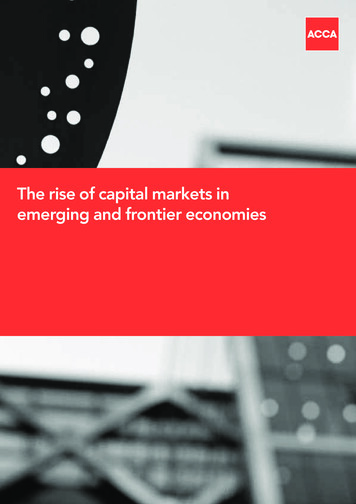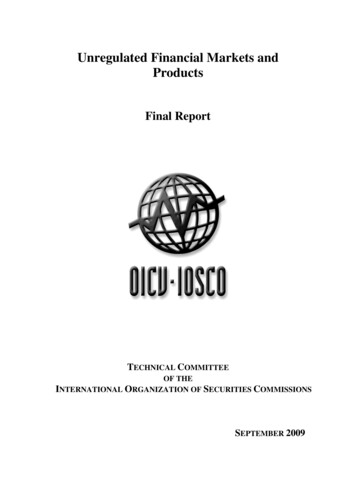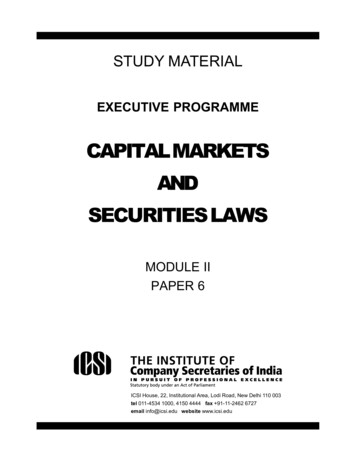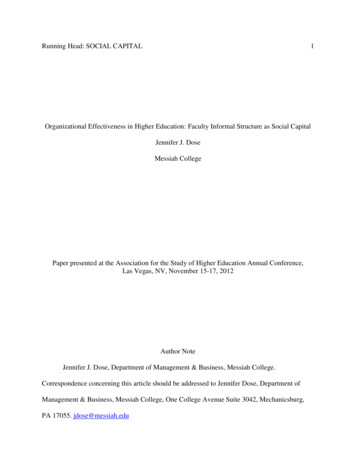
Transcription
The rise of capital markets inemerging and frontier economies
ABOUT ACCAACCA (the Association of Chartered CertifiedAccountants) is the global body for professionalaccountants. We aim to offer business-relevant,first-choice qualifications to people of application,ability and ambition around the world who seek arewarding career in accountancy, finance andmanagement.Founded in 1904, ACCA has consistently held uniquecore values: opportunity, diversity, innovation,integrity and accountability. We believe thataccountants bring value to economies at all stages oftheir development. We seek to develop capacity in theprofession and encourage the adoption of globalstandards. Our values are aligned to the needs ofemployers in all sectors and we ensure that, throughour qualifications, we prepare accountants forbusiness. We seek to open up the profession topeople of all backgrounds and remove artificialbarriers, innovating our qualifications and theirdelivery to meet the diverse needs of traineeprofessionals and their employers.We support our 140,000 members and 404,000students in 170 countries, helping them to developsuccessful careers in accounting and business, basedon the skills required by employers. We work througha network of 83 offices and centres and more than8,000 Approved Employers worldwide, who providehigh standards of employee learning anddevelopment. Through our public interest remit, wepromote appropriate regulation of accounting andconduct relevant research to ensure accountancycontinues to grow in reputation and influence.CONTACTEmmanouil Schizassenior policy adviseremmanouil.schizas@accaglobal.comtel: 44 (0)20 7059 5619 The Association of Chartered Certified Accountants,March322012Capital markets promoteeconomic development andgrowth by facilitating anddiversifying firms’ access tofinance. In order to do thisthey rely on institutions,including sound financialreporting and assurance, andthese in turn depend on theaccounting profession. Thisdiscussion paper considershow these relationships workand how policymakers canbuild on them.
The rise of capital markets inemerging and frontier economiesExecutive summaryCapital markets play an important role in promotingeconomic activity worldwide by facilitating anddiversifying firms’ access to finance. At the macro level,deepening capital markets, which have ample liquidityand developed secondary markets, are also reshaping thedeveloping world, driving wealth creation and the emergenceof powerful regional trading blocs. The fortunes of ACCA’sglobal membership are strongly tied to these developments.In emerging and frontier economies, the benefits thataccrue to national economies as capital markets growthand deepen are potentially greater, but they are alsoparticularly sensitive to a host of institutional variables,including competition, protection of minority investorsand overall business productivity. Because of this,supporting the development of capital markets usuallyinvolves a broad and ambitious programme of reform.Even then, successful market-builders need to be alert tosigns that markets might be outgrowing the social andregulatory capital on which they rely. The need forvigilance is especially great because, as the crisis of2008–9 demonstrated, markets can continue to grow andattract liquidity even as institutions are being erodedaway from underneath them.The system of financial disclosures is one such institution,and there is evidence to suggest it might be one of themost important ones. The perceived strength ofaccounting and auditing standards is a leading indicatorof the health of capital markets and a strong predictor ofthe growth effect of market liberalisation. While the crisisof 2008–9 dented confidence in disclosures withindeveloped countries, emerging markets have seenperceptions slowly recover and, perhaps as importantly,converge. Frontier markets, on the other hand, are notkeeping up, meaning that some of the most promisingeconomies in the world may soon not have the capitalmarkets to match their dynamism.As things stand, the momentum in favour of larger anddeeper capital markets in the developing world issubstantial but not irreversible. While marketcapitalisation has grown impressively and kept pace withlevels of growth seen in the developed world, marketliquidity has not. Although emerging economies are betteroff without the excess liquidity that the most developedcapital markets saw leading up to 2007, it remains thecase that markets need to deepen further if they are tohelp finance the rapid growth expected in theseeconomies.As a rule, the distinction between ‘frontier’ and‘emerging’ market status (see Appendix for aclassification) is sharper than that between ‘emerging’and ‘developed’ markets. If the intention of policymakersin frontier markets is to benchmark against emergingones, then policy will tend to focus on ensuring financialstability and improving the supply of financial servicesother than banking, while also developing the bankingsector and improving the wider business environment. Inemerging markets, on the other hand, the need toreplicate the institutions of developed ones is not selfevident. If there are shortcomings in comparison, they willtend to have more to do with the use of professionalmanagement, the protection of minority shareholders andaccess to financial services among the wider population.That said, the development of domestic capital markets isnot linear and policymakers should not obsess aboutmetrics such as liquidity. The needs of liquidity providersare not necessarily the same as those of investors and itis possible for markets to provide a better environmentfor the former rather than the latter, to the eventualdetriment of all. Moreover, headline levels of liquidity canmask substantial misallocations (for instance at theexpense of smaller businesses) that direct capital to lessthan optimal uses.This paper argues, on the basis of sound evidence, thatimproved disclosure, both mandatory and voluntary, isone of the few sustainable means of attracting liquidity.The experience of markets around the world shows thatthe timely and credible disclosure of company informationtends to promote investor confidence and attractadditional listings, thus broadening the benefits to thedomestic economy. In principle, disclosure also serves toreduce the cost of capital by reducing informationasymmetries, especially in developing countries with highstandards of market conduct. That said, the mechanismthrough which this is achieved is complex and sometimesappears to produce contradictory results.Disclosure and compliance, however valuable, both comeat a cost and thus policymakers are faced with a difficulttrade-off. On one side are those, mostly in emerging andfrontier markets, who believe that only strong andconsistent regulation can build enough confidence tomake a market viable. On the other side are those, mostlyin developed markets, who argue that disclosure andother regulatory requirements can easily becomedisproportionate, making markets inaccessible to all butTHE RISE OF CAPITAL MARKETS IN EMERGING AND FRONTIER ECONOMIES1
the largest or most determined issuers. The evidenceexamined in this discussion paper suggests thatpolicymakers can, through consistent and strictenforcement of proportionate rules, build a strongregulatory ‘brand’ for their markets that will attractdomestic and even foreign firms.This research additionally examined a number ofchallenges peculiar to emerging and frontier economies,which arguably merit further discussion. First, the paperconsiders the role of foreign investment, asking howemerging economies can manage ‘hot money’ andwhether attracting foreign investment is a self-evidentgoal. Second, it discusses the often-overlookedcontribution of privatisations to the development ofcapital markets and questions whether discussions ofgood practice are consistent with environments in whichformer state-owned enterprises (SOEs) are themainstream rather than exceptions to the profile of thetypical listed firm. Similarly, it examines the contributionof pension funds and pension reform to the growth ofcapital markets, stressing matters of quality rather thanquantity and the need for careful, gradual reform. Finally,it looks at the important complications introduced by theprevalence of large family firms in emerging markets –substantial principal–principal conflicts that canundermine confidence and necessitate enhancedcorporate governance arrangements, often directlyinvolving the accounting profession.Overall, this review makes a strong case for comparingand learning from the performance of capital marketswith their institutional context in mind. It also uncoversconsistent themes around the value of governance anddisclosure that can guide policymakers around the world.This will provide a solid foundation for ACCA’s work,engaging experts in emerging and frontier markets in adebate about the future of business finance.2
1. IntroductionEven before the financial crisis of 2008–9 and theeconomic downturn that followed it, the developing worldwas growing much faster than developed economies.Since the third quarter of 2009, more than half of theworld’s economic growth has come from transitional andemerging economies (UN 2011). This trend is epitomisedby the rise of the BRIC countries (Brazil, Russia, India,and China), all of which are currently ranked among thetop ten economies in the world, and forecast to rankamong the top six by 2020 (CEBR 2011). Since thefinancial crisis, this substantial imbalance in futuregrowth prospects has fuelled a swift recovery of bothdirect and portfolio investment, often to above pre-crisislevels (see Table 1), as more foreign investors have soughtto profit from growth in these markets or simply todiversify their portfolios away from advanced economies.Policymakers have their own reasons for encouraging thegrowth of domestic capital markets. Most important, ofcourse, are the benefits to economic growth from a moreefficient matching of savings with productive investment.Nonetheless, improved governance and accountability,especially among dominant private firms, are also part oftheir motivation. Economic planning, the reasoning goes,is much easier if a great deal of a country’s output,employment and tax revenues are linked to firms that aretransparent and/or accountable to the public. In fact, it isarguable (though this view has been sorely tested over thelast few years) that markets can scrutinise the conduct oflisted firms more rigorously, and penalise misconductmore effectively, than governments can afford to do.From ACCA’s perspective, the fortunes of ACCA’smembership in developing countries are more intimatelytied to the fortunes of major financial centres and, byextension, to those of capital markets, than those ofmembers in developed nations (see Figure 1). Nearly half(48%) of ACCA’s members in the developing world claimto work in financial centres of international significance,against 37.5% in the OECD countries. This figure rises toover 80% in locations such as Singapore or Hong KongSAR, which are home to some of the world’s deepest andmost developed capital markets (ACCA 2011).While firms in emerging markets can and do raise capitalabroad, there are strong information advantages (bothlegitimate and otherwise) and often significant savingsinvolved in listing domestically or at least in a regionalfinancial hub (Sarkissian and Schill 2009). The result isthat foreign investors can rarely tap into the potential offirms in emerging or frontier markets without someunderstanding of, or even presence in, their homecountries or regions. Moreover, many internationallyactive firms often find it difficult to enter fast-growingmarkets without a regional presence, and thus have aninterest in the development of regional capital markets.Table 1: Investment in developing and transition countriesAverage annual flowsAnnual flows (2010 part-estimated, 2011 ng countriesNet direct investmentNet portfolioinvestmentNet investmentTransition countriesNet direct investmentNet portfolioinvestmentNet investmentSource: UN (2011)THE RISE OF CAPITAL MARKETS IN EMERGING AND FRONTIER ECONOMIES3
Figure 1: ACCA regions and selected markets by share of members working in financial centres,by level of (self-assessed) international importanceCumulative share of members working inlocal, international and global financial sentres010%20%30%40%50%60%70%80%Non-OECDOECDSouth AsiaMiddle EastAfricaAsia PacificCEEAmericasWestern EuropeHong Kong SARPakistanCyprusSingaporeMauritiusChina (ex HK)MalaysiaIrelandUKNational or local4International or regionalGlobal90%100%
2. Understanding market developmentWHY DO CAPITAL MARKETS MATTER?Capital markets, including markets in equity, debt, andderivative products on these underlying assets, play animportant role in promoting economic activity. In primarymarkets, businesses and sovereigns issue financialinstruments representing claims against their future cashflows and use these to tap large regional and global poolsof savings in order to finance themselves. Secondarymarkets, on the other hand, provide an exit for investorsand facilitate price discovery – the accurate valuation ofinstruments that ensures issuers are paying anappropriate price for their access to finance and investorsare adequately compensated for the risk they take inproviding it. Liquidity providers are crucial to this latterfunction, as they take advantage of their superiorexpertise and information in order to arbitrage awayinconsistencies in valuations as well as differences in riskappetites between investors.For instance, Bekaert et al. (2005) note that countrieswith high-quality institutions reap three times the benefitfrom liberalisation than those with low-quality institutions,while those benefiting from a regulatory and policyenvironment that encourages investment tend to seemore than four times the benefit that others do. Moreover,Gupta and Yuan (2009) note that capital marketliberalisation yields higher benefits for incumbent firms insectors and markets in which competition is low; newentrants generally benefit only if liberalisation isaccompanied by pro-competition reforms.One final benefit from the development of capital marketsin developing countries is their ability to diversify firms’sources of finance. Such diversification can help createnot only faster but also more stable economic growth byensuring that shocks to the supply of bank credit do nothave disproportionate effects on that growth (Hawkings2002).In performing these functions, the growth and deepeningof capital markets can have a significant positive effect onnational growth and development. Market depth is not thesame as growth: deep markets benefit not only fromincreased liquidity but also from the presence ofdeveloped secondary markets in which securities can betraded, providing an exit for investors and an opportunityfor price discovery.In light of these findings, as well as the established factthat affluent countries have more developed capitalmarkets (Beck and Demirguc-Kunt 2009), thedevelopment of such markets has long been considered aprerequisite for economic growth. Accordingly, bothexternally introduced and home-grown developmentstrategies all over the developing world emphasise thedevelopment of capital markets (Stiglitz 2004).At the global level, Bekaert et al. (2005) find that equitymarket liberalisations led to over one percentage point ofadditional economic growth in those countries thatimplemented them in the late 20th century. As long asdomestic government debt remains at moderate levels(less than 35% of bank deposits), the growth of bondmarkets contributes positively to economic growth (AliAbbas and Christensen 2007) and provides a basis for thedevelopment of other capital markets (Chami et al. 2009).While the link between financial development andeconomic growth is generally taken for granted, it isimportant to remember that much of the relevantinternational evidence is severely dated. Rousseau andWachtel (2011) find that this relationship weakenedsignificantly in the first decade of the 21st century, evenbefore the financial crisis of 2008–09, as rapid financialdevelopment without corresponding strengthening ofinstitutions caused markets in many parts of the world tobecome increasingly fragile. The need to ensure thatcapital markets do not outgrow the institutions on whichthey rely had in fact been stressed well before 2007, forinstance by Stiglitz (2000). Increasing market liquidity, asimportant as it is, must not be seen as an end in itself.While the assumption is often made that developingcountries have the most to gain from such reforms, theireffect depends on how much additional investmentmarkets can unlock and how productive this investmentcan be. Therefore, in practice, it is those countries withthe highest-quality institutions that benefit the most interms of growth. In emerging markets, this means thatthe benefits accruing to national economies as capitalmarkets grow depend on a host of other institutionalreforms in order to deliver benefits.Regardless of their actual link to economic growth, strongcapital markets have been shown to drive trade andeconomic ties between emerging economies. Increasingfinancial development has not only served to increasetrade by and with emerging markets, but has alsocontributed more to growth in trade and economicTHE RISE OF CAPITAL MARKETS IN EMERGING AND FRONTIER ECONOMIES5
interdependence between these than between emergingand developed markets. This is documented by Demirand Dahi (2011) for the banking sector but also by Beineand Candelon (2011) for stock markets. In one sense,deepening capital markets are contributing significantlyto the emergence of influential regional economic blocs inthe developing world.THE STATE OF PLAYIn their definitive review of the evidence from 1960 to2007, Beck and Demirguc-Kunt (2009) document a strongtrend for deepening capital markets around the world, butnote that this has been more evident in developed than indeveloping countries.In the latter, market capitalisation has largely grown asfast as in the developed world, but trading volumes andliquidity have not. Moreover, in the period leading up tothe financial crisis of 2008–9, the general trend was forstock markets to grow faster in terms of capitalisationthan the banking sector, especially in Eastern Europe,Central Asia, the Middle East and Africa. This trend has,however, been absent in South Asia and has even beenreversed in Latin America.While public bond markets are more or less as large, interms of the ratio of market capitalisation to GDP, in bothdeveloped and developing markets, stock marketcapitalisation is much lower in less developed countriesand so is capitalisation of private (corporate) bondmarkets. In fact, the latter are so sensitive to economicdevelopment that data are scarcely available for the leastdeveloped markets – many of which have only very limitedinstitutions in place for the trading of corporate debt.What is very striking, however, is the substantialdifference in market liquidity that distinguishes developedmarkets from emerging as well as frontier capitalmarkets. As Table 2 shows, trading volumes in developedmarkets in which ACCA has a particular interest (seeAppendix) are typically ten times larger than those inemerging markets. And while excess liquidity haspotentially negative side effects, liquidity in general isalso instrumental in explaining the superior ability ofdeveloped capital markets to allocate capital efficiently toproductive business activity.Table 2: Median financial indicators for selected groups and outlier countries among major ACCA marketsGroupings(see Appendix)Public bondmarket Cap toGDPStock marketvalue traded SME loans as% of GDPStock market capto GDPInformal equityPrivate bondto GDP market cap to elandRussia and the UkraineMain GroupsOutliersTotal sampleSources: See Appendix6
Derivative markets are still relatively small in emergingmarkets (Mihaljek and Packer 2010). At a turnover ofaround 6% of GDP, they are about a sixth of the size oftheir equivalents in developed markets, and instrumentsare mostly traded over-the-counter (OTC) as opposed tothrough exchanges. Emerging derivatives markets are,however, growing faster than their equivalents in developedmarkets. Driven by increasing finance openness, the risein international trade and rising per capita incomes, theyhave grown four-fold in the last decade (2000–10) alone.As a consequence, export-driven economies have seentheir domestic markets grow the most: Korea, Brazil,Singapore and Hong Kong SAR have experienced the mostsignificant growth. In keeping with the significant foreignexchange (FX) risks to which these economies are exposed,the fastest-growing markets are in FX derivatives, withmarkets in interest-rate derivatives lagging behind.BENCHMARKING CAPITAL MARKETSFigure 2: Market characteristics and performance atdifferent stages of development (1)Figure 3: Market characteristics and performance atdifferent stages of development (2)Using data from the World Economic Forum (WEF) WorldCompetitiveness and Financial Development Reports(Bilodeau 2010; Sala-i-Martin et al. 2011) and theclassification of ACCA’s major markets shown in theAppendix), it is possible to illustrate how marketsclassified as ‘frontier’, ‘emerging’ or ‘developed’ differ ingeneral terms. It is important to remember that there isno simple linear progression from less to more developedmarkets; some types of market infrastructure andinstitutions represent necessary conditions fordevelopment while others are simply ‘nice-to-have’. Inaddition, what may appear as evidence of developmentcould simply turn out to be fleeting exuberance.Regulation ofsecurity vironment35Venture FinancialstabilityReliance on professionalmanagementBankingDeveloped4Strength ofauditing andreportingstandardsEmergingProtection of minorityshareholder interestsFrontierNote: Survey-derived scores are on a scale of 1 (lowest possible strength of development) to 7 (highest possible strength of development).Sources: Sala-i-Martin et al. (2011) and Bilodeau (2010).THE RISE OF CAPITAL MARKETS IN EMERGING AND FRONTIER ECONOMIES7
As a rule, frontier markets lag behind emerging marketson many dimensions much more than the latter lagbehind developed markets. Compared with frontiercapital markets, emerging ones perform substantiallybetter in almost all respects. The biggest difference by farappears to be in the development of non-banking financialservices, followed at a distance by improvements in theoverall business environment and the development of thebanking sector. Financial stability is also a big differencebetween frontier and developing markets – a hygienefactor in the development of fledgling capital markets, butone that in turn depends on a complex set of macroeconomic conditions.Compared with countries that host emerging capitalmarkets, countries with developed markets still performbetter on almost all measures. Particularly notable arethe increased use of professional management andprotection of minority shareholders as large family-ownedfirms adjust to public ownership and scrutiny.Additionally, extending financial access to a widersegment of the population allows large amounts of retailsavings to be invested in the capital markets, adding totheir depth and liquidity. The exception to the generaloutperformance of developed markets is financialstability: in the aftermath of the crisis in 2008–9,developed capital markets are no longer seen as anymore stable than emerging ones.Figure 4: Relative difference in WEF competitiveness and financial development scores between frontier, emerging anddeveloped markets010%20%30%40%50%60%70%80%90%100%Venture capital availabilityReliance on professional managementProtection of minority shareholder interestsStrength of auditing and reporting standardsRegulation of security exchangesFinancial access441%Non-banking financial servicesBanking financial servicesFinancial stabilityBusiness EnvironmentInstitutionsFrontier to emergingSources: Sala-i-Martin et al. (2011) and Bilodeau (2010).8Emerging to developed
3. Accounting as a catalyst of financial developmentWhile Bekaert et al. (2005) document a number ofinteresting relationships between market institutions andthe effect of capital market development on growth, theysingle one out for its magnitude and relevance. This is thelink between the strength and quality of accountingstandards and the incremental growth brought about bycapital market liberalisation. Countries with belowaverage quality of disclosures saw almost no gains ineconomic growth at all in the late 20 th century (0.04%)compared to those with above average standards (1.1%).This finding is not altogether surprising. As Figures 5 and6 show, in ACCA’s major markets the perceived quality ofaccounting standards i s positively related to equitymarket capitalisation and ease of access to the domesticequity market. In the case of access to equity markets,the perceived strength of accounting standards functionsIn order to understand the catalytic role played by thequality of accounting and auditing standards in thegrowth of capital markets, it is important to understandthe effect of disclosures on two key aspects of marketfunction: market liquidity and the cost of capital.Figure 6: Assessed strength of accounting and auditingstandards and ease of access to domestic equity marketsin major ACCA markets7766Ease of access to local equity marketSurvey scoresEquity market capitalisation/GDP (log scale)(World Bank)Figure 5: Assessed strength of accounting and auditingstandards and market capitalisation in major ACCAmarketsas a ‘hygiene’ factor, in that it appears to dictateminimum, as opposed to actual, levels of access. Yetdespite its importance, as Figure 6 shows, gains in thequality of disclosures are only moderate as marketsmature. In some cases this can set the stage for reducedstability in the future.54324321105123456Strength of accounting and auditing standards(Sala-i-Martin et al. 2011)701234567Strength of accounting and auditing standardsSource: Sala-i-Martin et al. (2011)THE RISE OF CAPITAL MARKETS IN EMERGING AND FRONTIER ECONOMIES9
MARKET LIQUIDITYInvestors in capital markets need exit opportunities,usually through secondary markets, in order to match thematurity of available securities to their own preferredportolios. This requires the function of brokers anddealers willing to build inventories of financial instrumentsand, while these are frequently denounced as merespeculators, their function is essential (Chami et al.2009). In fact, insufficient liquidity is very often cited asthe primary barrier to capital market development (egHearn and Piesse 2009).Chami et al. (2009) demonstrate that liquidity providersare generally attracted to a critical mass of borrowers andlenders but equally they need a set of rules governingtrading that are not unduly restrictive. They also benefitfrom trading mechanisms, including supporting clearingand settlement systems, which do not impose prohibitivetransaction costs. To minimise learning costs, liquidityproviders tend to require relatively large issue sizes andfrequent and/or regular issuance or, alternatively, longmaturities. Finally, liquidity providers rely on theexistence of financial instruments whose risk profilesincorporate mostly or exclusively market risk as opposedto a plethora of different risks; alternatively, otherinstruments through which market risk can, at least intheory, be isolated (eg by hedging all other sources of risk).When market rules and trading conditions are much morebenign for liquidity providers than for other investors, amarket can accumulate liquidity in good times, often fromoverseas, whose presence in the market is extremelyvolatile. Such excess liquidity during booms may beassociated with the rapid loss of market liquidity thatseveral developed markets saw during the financial crisisof 2008–9 and the sovereign debt crisis of 2010–11. Infact, such phenomena could prove to be self-reinforcingas fear that liquidity may drain from the market at shortnotice is likely to drive investors away.10In their review of 50 stock markets around the world,Frost et al. (2006) find that the strength of the disclosuresystem (disclosure rules, monitoring and enforcement,and information dissemination) is positively correlatedwith stock market liquidity. The timely and credibledisclosure of company information tends not only topromote investor confidence and encourage more activeparticipation in the market, but also to attract additionallistings, thus broadening the benefits to the domesticeconomy. On top of mandatory disclosures, voluntarydisclosures have also been shown to increase stockmarket liquidity by reducing bid-ask spreads (Haddad etal. 2009). Disclosures also have an indirect effect onemerging bond market liquidity. In their study of thedevelopment of Malaysia’s substantial bond market, Chanet al. (2007) find that strong credit ratings have asignificantly positive effect on liquidity.It is, however, important to note that overall marketliquidity is not an end in itself. Hearn et al. (2007) find,for instance, that investors demand a premium fromsmaller firms listed in key emerging markets above andbeyond what would be justified by market liquidity.
Capital markets promote economic development and growth by facilitating and diversifying firms' access to finance. In order to do this they rely on institutions, including sound financial reporting and assurance, and these in turn depend on the accounting profession. This discussion paper considers how these relationships work










